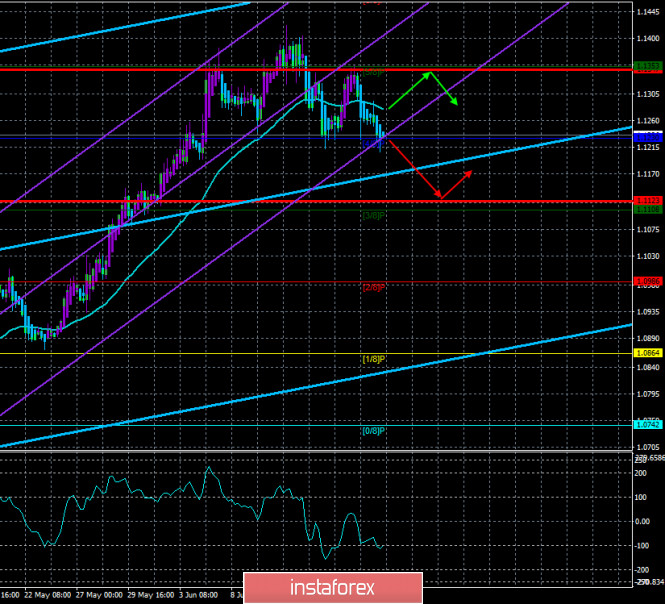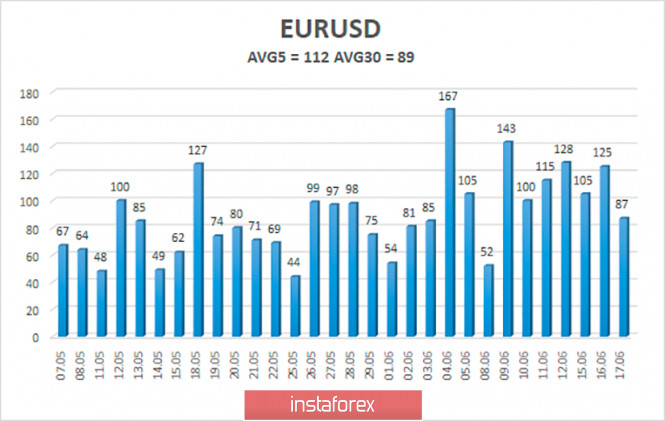4-hour timeframe

Technical details:
Higher linear regression channel: direction - upward.
Lower linear regression channel: direction - upward.
Moving average (20; smoothed) - downward.
CCI: -101.1232
The third trading day of the week was again relatively quiet trading. The euro/dollar pair resumed its downward movement and once again settled below the moving average line. In previous articles, we have repeatedly said that, from our point of view, the growth of the European currency in recent weeks was not completely justified. We do not see any good reasons for such a strong strengthening of the EU currency. However, the reasons, in any case, should have been covered in the United States, since the British pound also became more expensive during this period. However, even in this case, everything is ambiguous, since the Japanese yen and the Swiss franc often showed completely different dynamics. To our great regret, market participants continue to ignore most of the macroeconomic statistics, which makes it much more difficult to predict the pair's movement using fundamental analysis. By and large, it is now impossible to say exactly what factors traders pay attention to. Thus, we continue to recommend paying increased attention to technical factors.
Yesterday, the European Union published the consumer price index for May, which remained unchanged and amounted to 0.1% in annual terms and -0.1% in monthly terms. The forecasts were exactly like this, so there was no reaction from traders to this report. ECB Vice President Luis de Gindos, who often makes quite important statements, spoke in the afternoon. This time, the official said that the countries most affected by the "coronavirus" epidemic, such as Italy and Spain, need assistance, not in the form of loans, but in the form of grants. "If aid is provided through debt, it will only worsen the financial situation of some countries," de Guindos said. It would seem that the Vice-President of the ECB has not said so much, however, if you think about his words, it turns out that they make a lot of sense. We would like to note that in recent weeks, the issue of assisting the most affected economies of the European Union has moved not even to the second, but the third plan. It seems that everyone in the world felt that the European Commission and the European Council failed to agree on a recovery fund, so there is nothing to pay attention to. Recall that the last proposal was to form a recovery fund for 750 billion euros from the banal contributions of all EU member states, with further distribution of more than 2/3 of this amount in the form of grants and 1/3 in the form of concessional loans for the most affected countries and sectors of the economy. Experts immediately calculated that Greece, Spain, Italy, and Portugal will receive the lion's share of this amount. And those countries that have the smallest economy (and, consequently, have suffered the least) or the most financially stable countries ("northerners") will have to pay for it. And, of course, the Nordic countries have spoken out against such a "smart offer" and insist on an option in which money will be provided only on credit terms, and strict budget rules will be applied to countries that will limit their spending in the future to avoid possible collapse and bankruptcy. The southern countries do not want any loans but want to get money just like that. But they don't get anything yet. The European Council held several meetings this month, but each of them did not bring any results. Vice-President of the European Commission Maros Sefcovic said today that the EU countries need to agree on a recovery fund in July. On June 19, a new EU summit will be held in the format of a videoconference, which will again discuss the budget for the next seven years and the recovery of the EU economy. "We will discuss the package for the first time since its publication on May 28. Much work has been done in the Council to help prepare the ground and give all delegations a clear understanding of the various parts of the proposal. It is time for the members of the European Council to discuss this package in detail," said Charles Michel, President of the European Council. Thus, tomorrow the EU leaders will again discuss the topic of economic recovery, and we can only wait for the results of this meeting.
Jerome Powell's speech before the House of Representatives was no different from the speech before the Banking Committee. Thus, the lack of reaction of market participants to this event is logical. Jerome Powell twice promised that the Fed will use the full range of tools available to it to mitigate the consequences of the crisis and the epidemic for the population and business.
No important macroeconomic statistics are scheduled for Thursday, June 18 in the European Union. In the United States, only one report is scheduled for publication on this day – applications for unemployment benefits. Real unemployment is expected to continue to decline and the number of secondary applications will be 19.8 million instead of 20.9 million a week earlier. The number of new initial requests may again decrease compared to the previous week and reach 1.3 million. However, market participants are likely to ignore this report.
The key question now is whether the bears are ready to continue moving the euro/dollar pair south. If you look closely, the chart clearly shows the "head-shoulders" graphic pattern, which is a bearish pattern. Moreover, the pair's quotes for the second time in a few days have been fixed below the moving average, which also significantly increases the chances of a downward movement of the pair. Moreover, we believe that, from a fundamental point of view, the downward movement should continue, because, despite all the political, geopolitical, economic and social problems in the US, they are not enough for the US dollar to continue to fall in price on all fronts in the foreign exchange market. So far, from our point of view, nothing has happened in the US that would put the dollar in a much worse position compared to the euro.

The average volatility of the euro/dollar currency pair as of June 18 is 112 points. Thus, the value of the indicator is still characterized as "high", thanks to the last two weeks. We expect the pair to move today between the levels of 1.1123 and 1.1347. A reversal of the Heiken Ashi indicator back upward will signal a new round of upward correction.
Nearest support levels:
S1 – 1.1230
S2 – 1.1108
S3 – 1.0986
Nearest resistance levels:
R1 – 1.1353
R2 – 1.1475
R3 – 1.1597
Trading recommendations:
The euro/dollar pair returned to the area below the moving average line. Thus, at this time, sell orders with the goals of 1.1123 and 1.1108 are again relevant before the reversal of the Heiken Ashi indicator back up. It is recommended to return to buying the pair not before fixing the price above the moving target of 1.1347 and 1.1475.
The material has been provided by InstaForex Company - www.instaforex.com